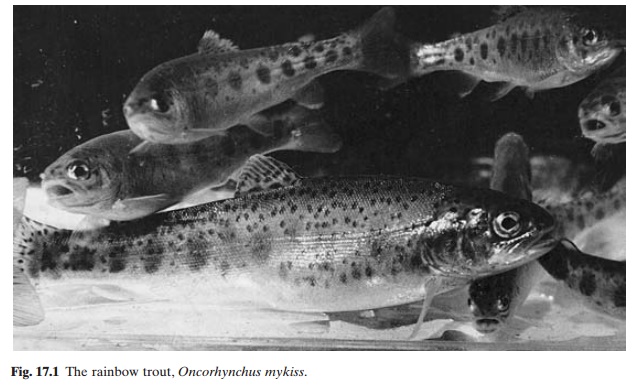Chapter: Aquaculture Principles and Practices: Trouts and Salmons
Trouts

Trouts
The trout species of the greatest importance in aquaculture is undoubtedly the rainbow trout (Oncorhynchus mykiss) (fig. 17.1). Native to the Pacific Coast drainages of North America, the rainbow trout has since 1874 been introduced to waters on all continents except Antarctica. Its range extends into low latitudes, at higher elevations. Trout waters are maintained in the upland areas of many tropical and subtropical countries of Asia, East Africa and South America, and commercial trout farming has developed in Central and South America and to a limited extent in some Asian and African countries like India and Kenya. As can be expected in a widely distributed and adaptable species like the rainbow trout, several local forms have developed, some of them described as distinct separate species or subspecies (see MacCrimmon (1971) for a list of some of them). Several strains have also been developed through mass selection and cross-breeding for improved cultural qualities.
The brown trout (S. trutta) is
the indigenous trout of Central and Western Europe, and was the first trout to
be artificially propagated. It has also been introduced into several countries
around the world for developing sport fisheries, by stocking natural water
bodies. Because of its slower growth rate, poor utilization of artificial feeds
and stringent water quality requirements, commercial cultivation of this species
has not developed to any appreciable extent, as compared to the rainbow trout.
Another trout which has received some attention is the brook trout (Salvelinus fontinalis), native to
north-eastern North America.The species was introduced into Europe towards the
end of the 18th century, and to a number of other areas where the water temperature
is between 12 and 14°C (not higher than 18°C). Because of the rather demanding
environmental requirements and susceptibility to infectious diseases and water
pollution, its culture is not very common now in spite of its fast growth rate
under favourable conditions and the high level of acceptability by consumers.
As indicated earlier, it is the rainbow trout that has now become the
mainstay of large-scale salmonid aquaculture on a worldwide basis. The two main
varieties of importance are the sea-going form known as the steelhead and a
land-locked fresh-water form. The steelhead grows very rapidly in salt water,
reaching 6–9kg in the sea in about three years. The fresh-water form, which is
the one usually used in commercial aquaculture today, attains a weight of 4.5kg
or more under favourable conditions. Sedgwick (1985) reported that this
fresh-water form attains weights of up to 9kg in the South American Andes,
indicating the potential of this species under suitable conditions. Even under
normal conditions, the rainbow grows faster than all other trouts and is more
adaptable to higher temperatures than the others, which enables its cultivation
under a wider range of climatic conditions and the utilization of higher water
temperatures for rapid growth rates.

The optimum water temperature in a rainbow trout farm is below 21°C,
although the lethal limit is in the region of 25–27°C, in which the animal may
survive for short periods but may not grow and be active.
Fish culturists in Europe prefer to maintain temperatures ranging over 10–15°C for as long as possible in their farms. While
higher temperatures would assist higher levels of metabolism and growth, it has
to be remembered that the dissolved oxygen content decreases as water
temperature increases. This situation can, however, be overcome by reducing the
stock density or by using special measures to increase the oxygen concentration
of the water. The minimum concentration needed for both rainbow and brown trout
is 6ppm, but it is not allowed to fall to that level and is maintained in a
fully saturated state.
The potential for expansion of trout farming, utilizing the advances of
culture technology and product development, is much greater than is generally
appreciated. In the vast areas of the South American Andes, where there are no
other comparable cold-water species available for aquaculture, there appear to
be considerable possibilities for developing large- as well as small-scale
trout culture. The experience in trout farm development in the upland areas of
Mexico clearly indicates its potential in creating rural self-employment and
commercial production, in areas with adequate supplies of good quality water.
In countries where commercial trout farming is already well developed, as in
Europe, increases in harvesting size from portion size (170–230g) to 350–450g
for the fresh fish market and to 1.5–3kg for fillets and smoked trout are
expected to stimulate market demand. This can be expected to lead to more
intensive production in existing farms and wider utilization of new
technologies such as cage farming.
Related Topics